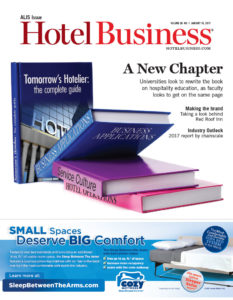The independent hotel segment, while hazy in definition, is one of the few sectors of the hospitality business predicted to have room left for substantial rate and RevPAR growth in 2017. Primarily, it comes down to timing.
Historically speaking, lower-priced and unbranded hotels are usually the last to recover from a recession, and both of these property types are prevalent in the independent sector. Therefore, at this stage of the cycle, with growth petering off among market trailblazers like the luxury and upper-upscale segments, the independent sphere is just now finally hitting its stride.
“One of the ways I tend to think of it is conceptually, the independents are still playing catch-up,” said R. Mark Woodworth, senior managing director, head of lodging research, CBRE Hotels’ Americas Research. “Everybody else came back before they did, so now it’s their turn. Our national projection for RevPAR growth in 2016 was 3.2%, but in our individual chainscale forecasts, our projected RevPAR change is less than 3.2%. It’s the independent hotels that are growing greater than the 3.2% nationally.”
But the independent sector is notoriously difficult to track, since property types can range anywhere from the smallest mom-and-pop roadside motels, to the trendiest urban luxury boutiques. That said, STR is projecting a minimal year-end 2017 occupancy decline of -0.5%, ADR growth of 3.0% and a RevPAR increase of 2.5%.
That 3.0% ADR projection is STR’s most aggressive rate forecast for any segment this year, reflecting both the current stage of the lodging cycle and the ability of independents to continue to push rate, regardless of price point. The segment may also end up doing better than anticipated in occupancy, since some hotels—particularly those on the lower end of the pricing scale—are still considerably down from historic absolute occupancy levels.
“If you look at our forecast for 2016, independents were the only group that we forecast to have positive occupancy growth, and I think that may be kind of what you see as we move into 2017,” said Bobby Bowers, SVP of operations for STR. “I think their occupancy change could be flat. We have them down 0.5%, but I think it may be better than that.”
Among the positive things going on in the segment, independent hotel owners stress the freedom their properties enjoy to manage as deemed appropriate, as opposed to branded hotels, which must adhere to chain policy. This could provide a crucial edge this year as new supply creeps into increasingly competitive markets.
“We think the independent hotel segment will benefit next year in softer markets because it has more of an ability to be nimble with pricing and distribution strategies,” said Andrea Foster, SVP of development, Marcus Hotels & Resorts. “It can react a little more independently.”
And on the full-service end of the independent spectrum, hoteliers are finding that food and beverage (F&B) is another valuable area where non-branded hotels can outpace competitors. Lacking brand visibility, strong F&B offerings can greatly help independent hotels create a buzz in the marketplace, while adding to the bottom line. In the most effective cases, F&B outlets are just as distinctive and memorable as the hotels in which they are located.
“People are looking for those unique experiences, so they often gravitate toward independent hotels for that,” said Foster. “Along that same vein, F&B is also where independent hotels may have a little bit of an opportunity as well. I’d say independent and boutique hotels will excel here in the future because they tend to have more experiential F&B options.”
Above all, insiders continue to stress the rising appeal of independent hotels, especially among millennials seeking a more unique lodging experience than what is generally offered in the branded space. This facet of the segment creates a notably different demand outlook than virtually all other chainscales, and different expectations for future performance as a result, especially with broader industry performance on the wane.
“Our ability to weather the storm is far better than the branded properties,” said Bashar Wali, principal and president of Provenance Hotels. “Suffice it to say in this cycle, the consumer has really seen the difference between the independent spirit and the vanilla boutique and lifestyle brands the chains have put out, which don’t have the authenticity that the independents truly have. The consumer sophistication in seeking the independent product, combined with independents’ ability to control expenses, I think will allow them to fare better than the brands during this down-cycle.”

